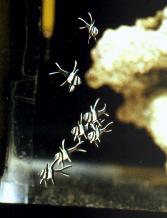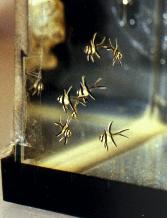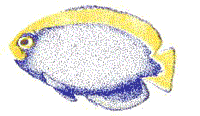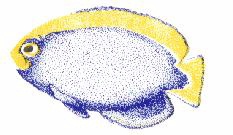|
Raising Banggai Babies
By Jim Stime, Jr.
I was cleaning tanks at the fish shop one day when one of the employee's
asked me what was wrong with one of the Bangaii Cardinals in our Reef Tank.
Having just lost one of them to some bacterial mouth disease, I expected
the worst. When I located the fish he was refering to I noticed that his
mouth was quite extended. Having been to my friend Cameron's, reef tank
the month before and seen his Bangaii Cardinals, and their babies ( which
he has had numerous hatchings ), I announced that this male was holding
babies.
" What should we do" I was asked, well not knowing, I said lets leave
him in the tank and see what happens. This employee had other idea's. Within
a couple of hours he had captured and placed him in one of the 30 gallon
tanks in the stores Invertebrate section. OK, lets see what happens.
 
The following morning ( December 15, 1996 ) we were amased to find Dad
and released fourteen Bangaii babies. The two photo's above show a group
of 24 hour old babies. They are about 3/16" in length, and were miniture
versions of their father. Notice that there are no egg sac's.
Knowing that they needed to eat, I did what Cameron had done, began
to hatch baby brine shrimp. There are many ways to hatch brine shrimp,
we did what the Waikiki Aquarium had suggested Cameron do, use a one gallon
molded plastic milk container, the kind with the handle molded into the
side, and place a rigid air line into the container with an air stone under
the molded handle, and a small lamp outside the container. The handle would
serve as a sort-of foam fractionator ( actually a shell-fractionator )
to drive the empty shells out of the water. The light would keep the water
warm, and could be used to congregate the baby brine to one side of the
container for collection. A Turkey Baster could then be used to suck the
shrimps from the container and dispensed into the tank for feeding.
After 24 hours I introduced the first few squirts of newly hatched baby
brine into the tank for the baby Cardinals. They went crazy going after
them, darting here and darting there. Since the father was much larger,
and there was the fear that he might eat his offspring, we removed him
and placed him back in with his partner in the reef tank ( which within
days he was holding babies again, but thats another story ).
It wasnt until the babies were 4 days old that I noticed one had died,
another week passed before we lost another baby. Why were they dying ?
I never saw any aggression towards each other, no fins were ever nipped
or broken. I suspect it was my casual pace ( actually lack of time ) in
feeding them on a regular basis. Numerous articles on larval and fish raising
suggest a frequent feeding schedule of 3 to 6 times a day. Unfortunately
with my heavy load of Aquarium Service customers I was not in the shop
very much. So once a day, sometimes twice, I would dispense 3 to 4 squirts
of 24 to 72 hour old baby brine into the tank, via the Turkey baster.
Over the next couple of months the babies grew at a rapid rate, attaining
the size of a dime, or 1/2" in diameter, but I still would loose about
one a week. I was now trying to feed adult brine, about 72 to 96 hour old,
the larger of the babies would nip at the brine, but the group still prefered
newly hatched brine. I also tried blood worms, which the larger of the
sibblings would eat, but the rest just watched. A few times I tried flake
food, none of them had any interest !
By the end of March, 1997, there were only two babies remaining and
I decided it was best to take them home to my tank where I could watch
and feed them on a more regular basis. Since I do not feed live food in
this tank, the new Cardinals had to get used to frozen foods. They would
see the food, but not chase after it. I suspect the reason it did not appeal
to them was that the food did not move. It was the 4th day before both
of the babies began to chase the food, and the 8th day before both were
eating the frozen food I put into the tank.
As of January 1998, the 2 Banggai Cardinals are about 2 1/2" head to
tail, and are feeding on a regular basis. As of September 2000 I have only
the one Cardinal fish left, and he is about 3" from head to tail.
In January of 1999 I found another male holding a mouth full of babies
in one of my service customers tanks. With his permission i captured the
male, who immediately spit out 13 babies. Over the course of the next six
months I slowly lost all but one of this batch. During this time I have
continually fed baby brine shrimp and my attempts to wean them off live
foods has resulted in a partial loss of the babies.
A couple of notes;
* Seems the babies only respond to live food, or food that moves. In
particular food of a certain size.
* Feeding should be done on a regular basis, at least twice a day, if
not more in the beginning.
* I got better results in growing baby brine shrimp in a dark enviroment,
as opposed to using the lamp along side the tank.
* In my first attempt I was fortunate to be able to use a tank that
was part of a 600 gallon system, so water quality was not a problem. My
second attempt I used a 10 gallon tank filled only 1/3 full. As expected
raising Bangghai Babies in this smaller tank require frequent water changes
due to the amount of food introduced.
|













